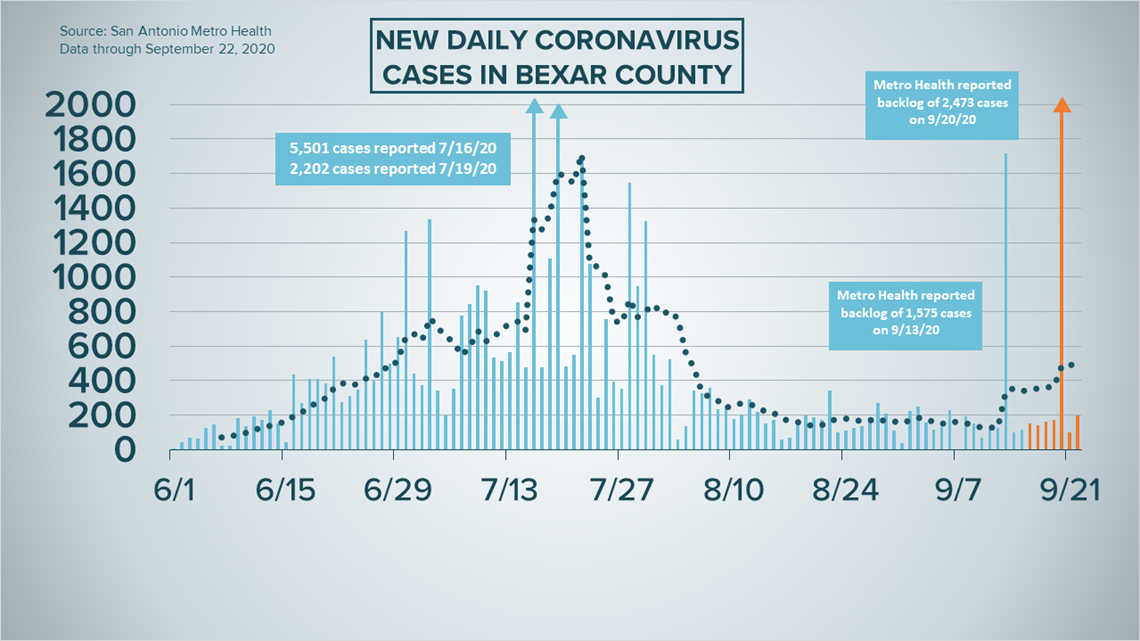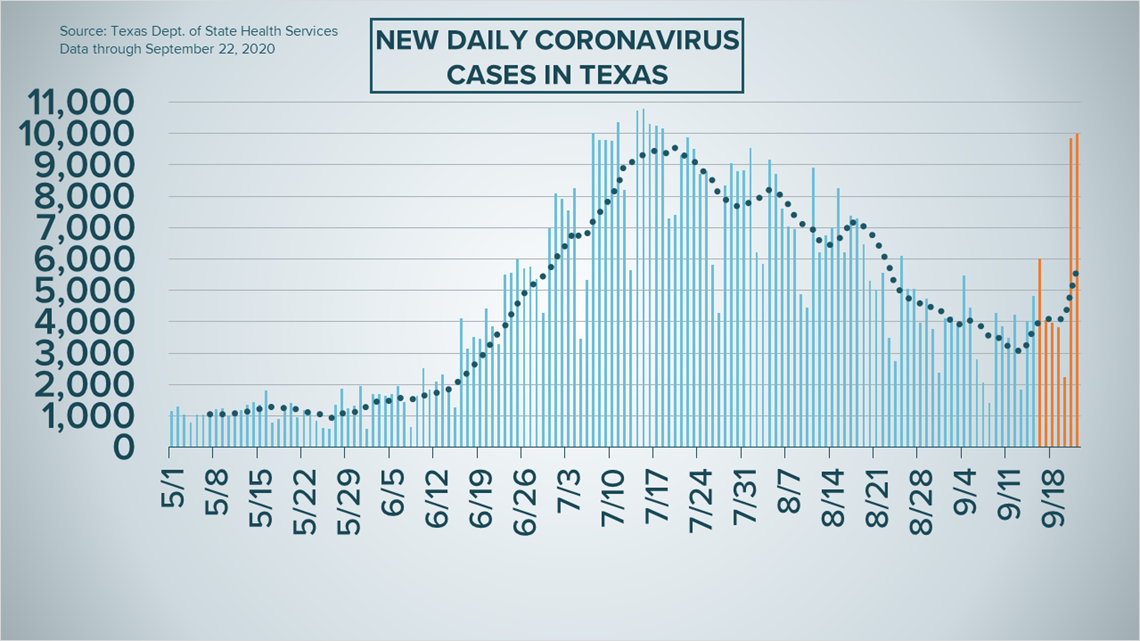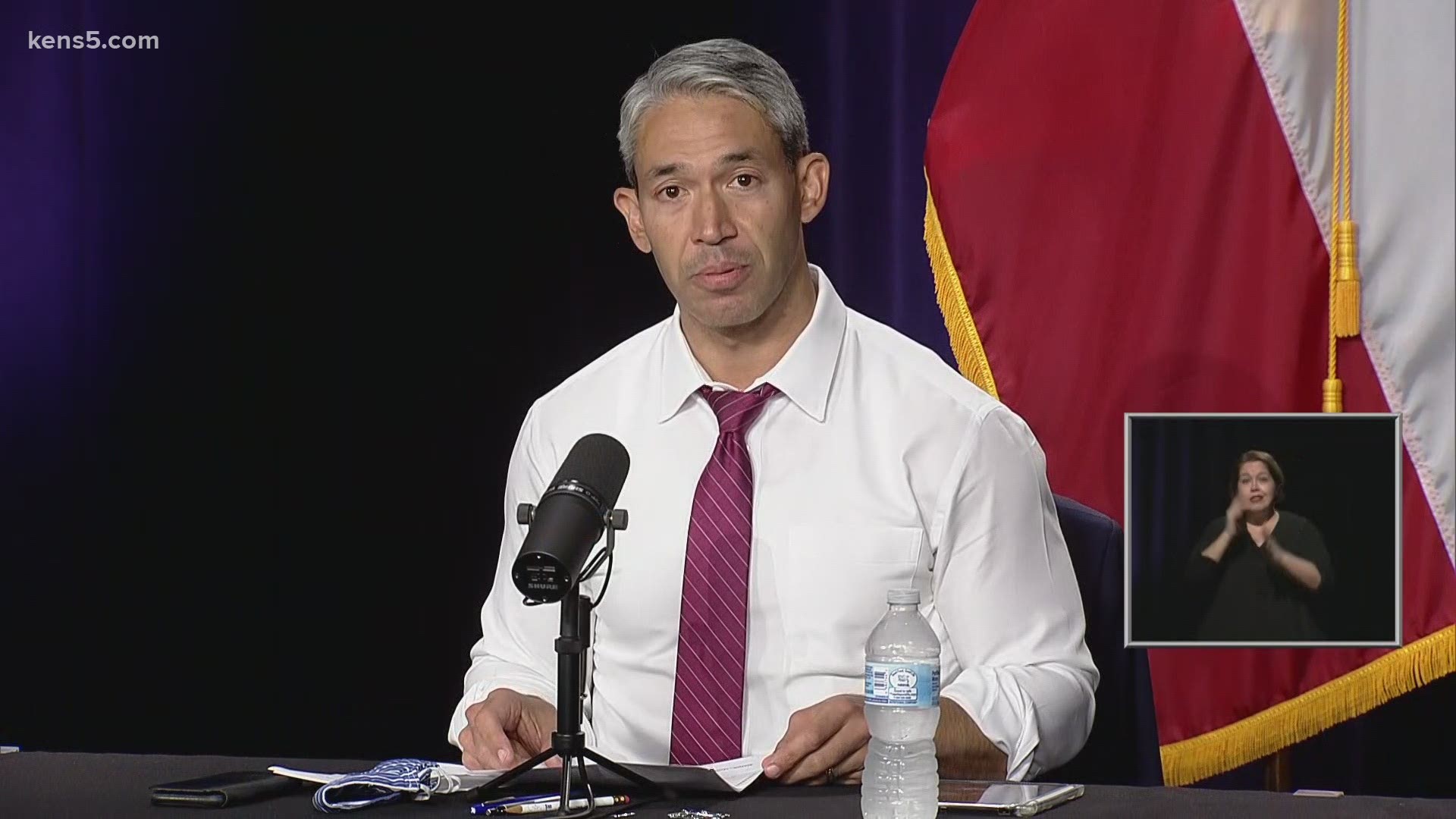SAN ANTONIO — We're tracking the latest numbers from the coronavirus pandemic in San Antonio and across Texas. Here are the latest numbers reported by Bexar and surrounding counties:
- Bexar County: 196 new cases were reported Tuesday, bringing the total number for the county to 56,639. The county death toll rose to 1,068 after six new fatalities were reported.
- Comal County: The county reported 53 additional cases on Tuesday. No additional deaths were reported. There have been a total of 3,349 cases of COVID-19 in the county – including 2,642 confirmed cases – while 116 county residents have died. County officials say there are 250 active coronavirus cases, and 2,983 residents are considered recovered.
- Hays County: Officials in Hays County on Tuesday reported 21 new cases in the county and no additional virus-related deaths. As of Tuesday, there are a total of 5.799 lab-confirmed cases in the county (1,694 of which are active) while the death toll stands at 52. 4,053 residents have recovered from the virus.
How Bexar County is trending
We've tracked how many coronavirus cases have been confirmed in Bexar County from the time officials began reporting cases in March 2020. The graphic below shows the number of cases since June and charts those daily case numbers along a 7-day moving average to provide a more accurate picture of the overall coronavirus case curve in our area and the direction we're trending amid the pandemic.
On Tuesday, San Antonio Mayor Ron Nirenberg reported 196 additional coronavirus cases in Bexar County, raising the total to 53,639 since the pandemic began. The seven-day moving average for newly-reported cases is up to 148
The death toll rose by six on Tuesday; in all, 1,068 Bexar County residents have passed away from COVID-19 complications.


Hospitalizations rose by seven on Tuesday, up to 233. The number of local coronavirus patients on ventilators (42) and the number of patients in intensive care (86) rose slightly.


School risk level remains in the "moderate zone." Nirenberg noted that city leaders are still holding out for the positivity rate to drop further to 5%.
Monday, during his weekly update of the county's risk level and progress indicators, Nirenberg noted the positivity rate ticked up slightly to 6.4%. Bexar County remains in the "safe zone" for the third week in a row.
City Manager Erik Walsh announced the timeline for reopening several city services as the city moves into Phase 3 of its four-step reopening plan.
Effective immediately, basketball courts, skate parks, playgrounds, sports fields, and fitness stations at city parks have reopened. Parks no longer have a 10-person limit as of Monday.
Coronavirus in Texas
The number of Texans who have tested positive for the coronavirus since the pandemic began grew by 17,820 Tuesday, according to the Texas Department of State Health Services. Of that increase, 3,964 are attributed to newly-reported coronavirus cases. Another 13,856 cases in the total stem from a number of backlogs throughout several counties:
- 2 cases recently reported by labs in Dallas County
- 13,622 cases recently reported by labs in Harris County
- 231 cases recently reported by labs in Nueces County
- 1 case recently reported by labs in San Jacinto County
In total, 716,207 Texans have tested positive for COVID-19.


Meanwhile, the state also reported 77 new virus-related fatalities. In all,14,994 Texans have died from coronavirus complications. The number of hospitalizations on Tuesday rose to 3,207; that's 75 more Texans receiving treatment for COVID-19 symptoms in the last 24 hours.
State officials estimate 613,896 Texans have recovered while 87,317 remain ill with the virus.
The state's public school COVID-19 data dashboard shows 2,344 positive cases out of 1.1 million students learning in-person. DSHS says that’s less than .5 percent of the total student population who are learning in-person. The total count of on-campus staff cases during the same period is 2,175.
The data on the DSHS' website will be updated weekly on Wednesdays. Beginning Sept. 23, it will include data by school district.
Latest Coronavirus Headlines
- 'Unfathomable': US death toll from coronavirus hits 200,000
- Tommy DeVito, Four Seasons founding member, dies of COVID-19 at 92
- CDC issues Halloween guidance, discourages traditional trick-or-treating
- Who's Hiring: Companies still looking for employees during coronavirus pandemic
- How some universities and colleges are handling admission tests during the pandemic
- How San Antonio's museums are surviving during the coronavirus pandemic
Coronavirus symptoms
The symptoms of coronavirus can be similar to the flu or a bad cold. Symptoms include fever or chills, cough, shortness of breath or difficulty breathing, fatigue, muscle or body aches, headache, new loss of taste or smell sore throat, congestion or runny nose, nausea or vomiting and diarrhea, according to the Centers for Disease Control.
Most healthy people will have mild symptoms. A study of more than 72,000 patients by the Centers for Disease Control in China showed 80 percent of the cases there were mild.
But infections can cause pneumonia, severe acute respiratory syndrome, kidney failure, and even death, according to the World Health Organization. Older people with underlying health conditions are most at risk.
But infections can cause pneumonia, severe acute respiratory syndrome, kidney failure, and even death, according to the World Health Organization. Older people with underlying health conditions are most at risk.
Experts determined there was consistent evidence these conditions increase a person's risk, regardless of age:
- Chronic kidney disease
- COPD (chronic obstructive pulmonary disease)
- Obesity (BMI of 30 or higher)
- Immunocompromised state (weakened immune system) from solid organ transplant
- Serious heart conditions, such as heart failure, coronary artery disease, or cardiomyopathies
- Sickle cell disease
- Type 2 diabetes
The CDC believes symptoms may appear anywhere from two to 14 days after being exposed.
Human coronaviruses are usually spread...
- Between people who are in close contact with one another (within about 6 feet).
- Through respiratory droplets produced when an infected person coughs, sneezes or talks. These droplets can land in the mouths or noses of people who are nearby or possibly be inhaled into the lungs.
- Some recent studies have suggested that COVID-19 may be spread by people who are not showing symptoms.
Help stop the spread of coronavirus
- Stay home when you are sick.
- Eat and sleep separately from your family members
- Use different utensils and dishes
- Cover your cough or sneeze with your arm, not your hand.
- If you use a tissue, throw it in the trash.

